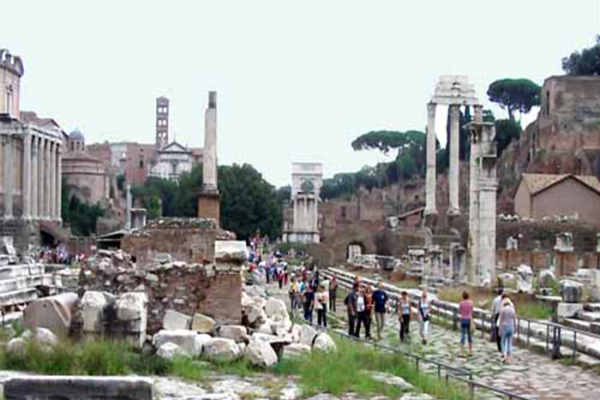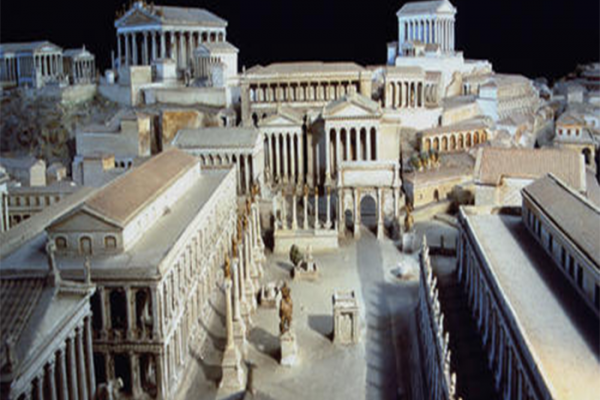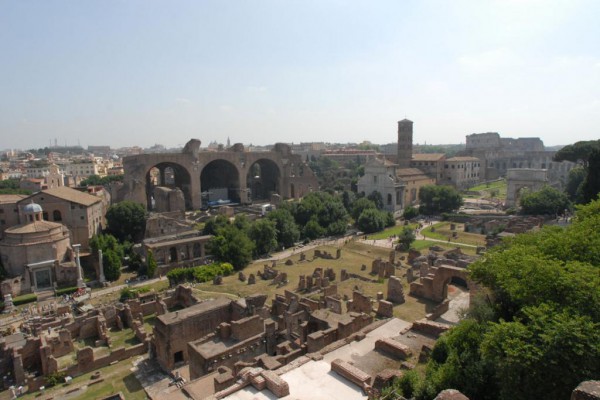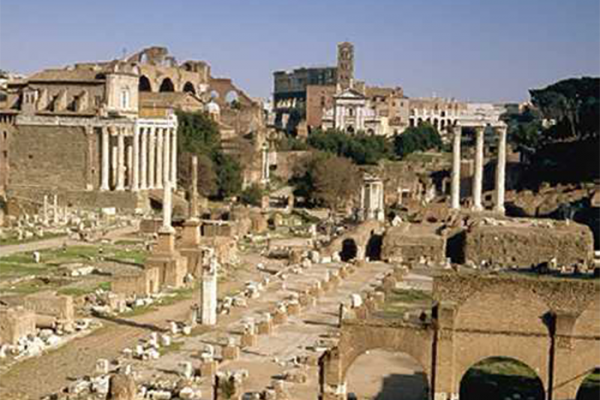
Il Colosseo, Il più grande anfiteatro del mondo e simbolo senza tempo della città di Roma.
Fu il primo anfiteatro costruito in pietra e, sicuramente, il più importante. Prima della sua costruzione i combattimenti tra gladiatori avvenivano in gradinate mobili poste all’interno del Foro.
Il Colosseo si cominciò a costruire durante il regno di Vespasiano nel I secolo e si concluse durante quello di Tito.
Sorse nel luogo dove, in precedenza, Nerone aveva creato un lago artificiale per abbellire il parco della sua villa, la “domus aurea”.
L’inaugurazione durò cento giorni e si uccisero cinquemila belve. E’ del VI secolo l’ultimo spettacolo di cui si ha notizia.
Pur non sapendo se si martirizzarono cristiani, il Papa percorre ogni anno una Via Crucis attorno al suo perimetro. Questa consacrazione religiosa dell’edificio lo salvò dal saccheggio; nonostante tutto il marmo che lo ricopriva è stato rubato, e proprio per questo al giorno d’oggi si possono notare dei piccoli buchetti nella pietra.
L’edificio è enorme, lo si può vedere dal Foro, dal Palatino e da molti quartieri vicini. Continua ad avere un fascino particolare, nonostante la grande quantità di turisti che lo affollano.
 Il Foro Romano, La valle del Foro tra i sette colli di Roma era anticamente una palude.
Il Foro Romano, La valle del Foro tra i sette colli di Roma era anticamente una palude.
Dalla fine del VII secolo a.C. dopo la bonifica della palude nella valle fu realizzato il Foro Romano che fu il centro della vita pubblica romana per oltre un millennio.Nel corso dei secoli furono costruiti i vari monumenti: dapprima gli edifici per le attività politiche, religiose e commerciali, poi durante il II sec. a.C. le basiliche civili, dove si svolgevano le attività giudiziarie. Alla fine dell’età repubblicana, l’antico Foro Romano era ormai insufficiente e inadeguato a svolgere la funzione di centro amministrativo e di rappresentanza della città.Le varie dinastie di imperatori aggiunsero solo monumenti di prestigio: il Tempio di Vespasiano e Tito e quello di Antonino Pio e Faustina dedicati alla memoria degli imperatori divinizzati, il monumentale Arco di Settimio Severo, costruito all’estremità occidentale della piazza nel 203 d.C. per celebrare le vittorie dell’imperatore sui Parti.L’ultimo grande intervento fu realizzato dall’imperatore Massenzio ai primi anni del IV secolo d.C. Massenzio fece costruire il Tempio dedicato alla memoria del figlio Romolo e l’imponente Basilica sulla Velia che fu ristrutturata alla fine del IV secolo d.C. L’ultimo monumento realizzato nel Foro fu la Colonna eretta nel 608 d.C. in onore dell’imperatore bizantino Foca.
 Il Palatino è uno dei sette colli di Roma, situato tra il Velabro e il Foro Romano.
Il Palatino è uno dei sette colli di Roma, situato tra il Velabro e il Foro Romano.
Il sito è ora un grande museo all’aperto e può essere visitato durante il giorno. L’ingresso si trova in via di San Gregorio (ingresso a pagamento), oppure si può salire sul Palatino entrando nel Foro Romano (ingresso a pagamento) e poi salendo per il Clivio Palatino, a destra dell’Arco di Tito.
Secondo la mitologia romana, il Palatino (più precisamente il pendio paludoso che collegava il Palatino al Campidoglio, chiamato Velabro) fu il luogo dove Romolo e Remo vennero trovati dalla Lupa che li tenne in vita allattandoli nella “Grotta del Lupercale”, forse recentemente localizzata. Secondo questa leggenda, il pastore Faustolo trovò gli infanti e, assieme a sua moglie Acca Larentia, allevò i bambini. Quando Romolo, ormai adulto, decise di fondare una nuova città, scelse questo luogo (si veda Fondazione di Roma per un resoconto più dettagliato del mito). La casa Romuli effettivamente era una capanna ricostruita e restaurata più volte, situata nell’angolo nord-ovest della collina, dove poi sorse la casa di Augusto. Scavi del 1946 hanno effettivamente trovato in questo sito resti di capanne dell’età del Ferro, confermando appieno la tradizione leggendaria.
Gli Imperatori Romani costruirono i loro palazzi sul Palatino. Le rovine dei palazzi di Augusto, Tiberio e Domiziano sono ancora visibili. Lo stesso termine palazzo deriva dal Palatium latino, a sua volta derivante da Palatino.
Augusto acquistò la casa dell’oratore Ortensio, situata accanto alla cosiddetta “casa di Romolo” ancora esistente, secondo la tradizione, nel 31 a.C., la ampliò con l’acquisto di case vicine e vi dimorò senza tuttavia farne un palazzo vero e proprio. Una parte della residenza era riservata alla moglie Livia, la cosiddetta “Casa di Livia” Attualmente le due residenze sono aperte al pubblico a giorni alterni. Nell’ambito della residenza, Augusto edificò il tempio di Apollo Palatino, con un ampio portico e biblioteche.
Durata tour: 4 ore
Inizio tour: 09:00 am – 13:00 pm
Visiterete:
• Colosseo
• Foro Romano
• Palatino
• Circo Massimo
Il tour include:
• Pick up in hotel con auto a disposizione per tour e rientro in hotel.
• Guida turistica esperta riservata per il vostro gruppo.
• Biglietti e tasse di prenotazione per tutti i siti visitati.
• Salta la fila per il Colosseo, Foro Romano e Palatino
The Colosseum, the largest amphitheater in the world and a timeless symbol of the city of Rome.
It was the first amphitheater built in stone and, certainly, the most important. Before its construction, the fights between gladiators took place in mobile stands placed inside the Forum.
The Colosseum began to be built during the reign of Vespasian in the first century and ended during that of Titus.
It was built in the place where Nero had previously created an artificial lake to embellish the park of his villa, the “domus aurea”.
The inauguration lasted one hundred days and five thousand beasts were killed. The last known show dates back to the 6th century.
While not knowing whether Christians were martyred, the Pope walks a Via Crucis around its perimeter every year. This religious consecration of the building saved it from pillage; despite all the marble that covered it was stolen, and for this reason today you can see small holes in the stone.
The building is huge, you can see it from the Forum, the Palatine Hill and many nearby neighborhoods. It continues to have a particular charm, despite the large amount of tourists who flock to it.
The Roman Forum, The valley of the Forum between the seven hills of Rome was in ancient times a swamp.
From the end of the 7th century BC after the reclamation of the swamp in the valley, the Roman Forum was built which was the center of Roman public life for over a millennium. Over the centuries the various monuments were built: first the buildings for political, religious and commercial activities, then during the II century. B.C. the civil basilicas, where judicial activities took place. At the end of the Republican age, the ancient Roman Forum was by now insufficient and inadequate to perform the function of the administrative and representative center of the city. Antoninus Pius and Faustina dedicated to the memory of the deified emperors, the monumental Arch of Septimius Severus, built at the western end of the square in 203 AD to celebrate the victories of the emperor over the Parthians. The last major intervention was carried out by the emperor Maxentius in the early fourth century AD. Maxentius had the temple dedicated to the memory of his son Romulus built and the imposing Basilica on the Velia which was renovated at the end of the 4th century AD. The last monument built in the Forum was the Column erected in 608 AD. in honor of the Byzantine emperor Phocas.
The Palatine Hill is one of the seven hills of Rome, located between the Velabro and the Roman Forum.
The site is now a large open-air museum and can be visited during the day. The entrance is located in via di San Gregorio (entrance fee), or you can climb the Palatine Hill by entering the Roman Forum (entrance fee) and then going up to the Clivio Palatino, to the right of the Arch of Titus.
According to Roman mythology, the Palatine Hill (more precisely the swampy slope that connected the Palatine to the Capitoline Hill, called Velabro) was the place where Romulus and Remus were found by the she-wolf who kept them alive by nursing them in the “Grotta del Lupercale”, perhaps recently located. . According to this legend, the shepherd Faustolo found the infants and, together with his wife Acca Larentia, raised the children. When Romulus, now an adult, decided to found a new city, he chose this place (see Foundation of Rome for a more detailed account of the myth). The Romuli house was actually a hut rebuilt and restored several times, located in the north-west corner of the hill, where the house of Augustus was later built. Excavations from 1946 actually found remains of Iron Age huts at this site, fully confirming the legendary tradition.
The Roman Emperors built their palaces on the Palatine Hill. The ruins of the palaces of Augustus, Tiberius and Domitian are still visible. The term palace itself derives from the Latin Palatium, which in turn derives from the Palatine.
Augustus bought the house of the orator Ortensio, located next to the still existing so-called “house of Romulus”, according to tradition, in 31 BC, he enlarged it with the purchase of neighboring houses and lived there without however making a real palace. Part of the residence was reserved for his wife Livia, the so-called “House of Livia” Currently the two residences are open to the public every other day. As part of the residence, Augustus built the temple of Apollo Palatine, with a large portico and libraries.
Tour duration: 4 hours
Tour starts: 09:00 am – 13:00 pm
You will visit:
• Colosseum
• Roman forum
• Palatine Hill
• Circus Maximus
The tour includes:
• Pick up at the hotel with car available for tours and return to the hotel.
• Expert tour guide reserved for your group.
• Tickets and booking fees for all sites visited.
• Skip the line to the Colosseum, Roman Forum and Palatine Hill






